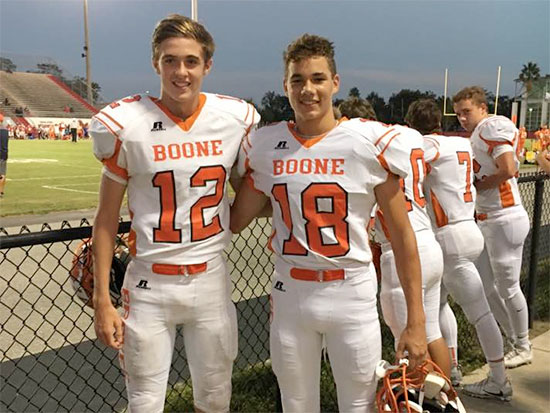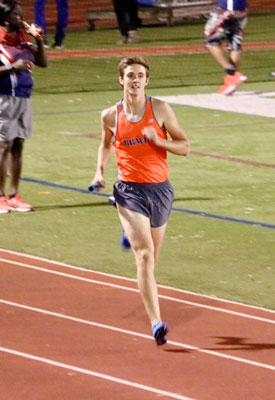 Thoracic outlet syndrome forced Nibert to switch from quarterback to linebacker.It’s hard to play baseball when you can’t grip the ball. Cole Nibert found that out the hard way. Now a high school junior in Orlando, Florida, Cole grew up playing third base, and was a quarterback in football.
Thoracic outlet syndrome forced Nibert to switch from quarterback to linebacker.It’s hard to play baseball when you can’t grip the ball. Cole Nibert found that out the hard way. Now a high school junior in Orlando, Florida, Cole grew up playing third base, and was a quarterback in football.
While in eighth grade, Cole had a bad bout with the flu. He got over it; but upon recovery, he found that his right arm did not work quite the way it should. His arm was numb, and he lost feeling in his right hand: bad news for a right-handed infielder and quarterback. That started Cole and his family on a long odyssey to find the cause — and find out what they could do about it.
“Thoracic outlet syndrome, or TOS, is rare and often is misdiagnosed,” said Richard Meyer, M.D., in the Department of Orthopedic Surgery at the University of Alabama at Birmingham School of Medicine. “We sometimes say a patient with TOS will see five doctors before they get a diagnosis, and seven before they get appropriate treatment.”
Meyer says TOS has symptoms very similar to other conditions such as carpal tunnel syndrome, rotator cuff injuries, cervical disc disorders, fibromyalgia, multiple sclerosis, complex regional pain syndrome and tumors of the spinal cord, making it extremely difficult to diagnosis.
Cole was lucky. His search lasted only about six months and led him to Jose Borrero, M.D., an Orlando surgeon who is an expert in TOS. Upon diagnosis, Borrero, who was curtailing his surgical practice, referred Cole to his colleague Meyer at UAB.
 Nibert took up track, competing in the 800 meters, following surgery.TOS is an umbrella term that encompasses three related syndromes involving compression of the nerves, arteries and veins in the lower neck and upper chest area and cause pain in the arm, shoulder and neck.
Nibert took up track, competing in the 800 meters, following surgery.TOS is an umbrella term that encompasses three related syndromes involving compression of the nerves, arteries and veins in the lower neck and upper chest area and cause pain in the arm, shoulder and neck.
“You can think of TOS as a kind of complicated carpal tunnel syndrome in the neck,” Meyer said. “Usually caused by a traumatic injury or unusual anatomy, we see nerves growing through muscle instead of in between muscle. When the muscle contracts, it puts pressure on the nerve.”
In Cole’s case, it was anatomy that was the culprit.
Cole had an extra rib, which caused the nerves leading from his spinal cord to his arm to be stretched out of place over his ribcage. Patients with an extra rib are at greater risk of having TOS, says Meyer. For Cole, the fix was to simply remove the offending rib.
“We took out the extra rib surgically, as well as the first rib on his right side,” Meyer said. “Taking out the ribs means the nerve no longer binds and has a clear pathway. If untreated, you have neck and shoulder pain that radiate down the arm, leading to numbness in the hand and fingers. You can lose muscle and function."
Meyer says patients begin to get feeling back right after surgery, but that the process to regain full normal function takes a long time.
“My surgery was in spring of 2017, and I’d say I’m at 85 to 90 percent now in late summer of 2018,” Cole said. “They say that I should continue to improve and ultimately regain full function.”
 Cole Nibert now volunteers at his local hospital, after surgery to remove an extra rib.He had to give up baseball, and while he still plays football, he had to switch to the other side of the line of scrimmage as a linebacker. He also took up track; but perhaps most importantly, he is now planning on a career in a medical field.
Cole Nibert now volunteers at his local hospital, after surgery to remove an extra rib.He had to give up baseball, and while he still plays football, he had to switch to the other side of the line of scrimmage as a linebacker. He also took up track; but perhaps most importantly, he is now planning on a career in a medical field.
“I’ve got some really gnarly scars, which are a good reminder of what I’ve been through,” Cole said. “I’m volunteering at Orlando Regional Medical Center, and that is really rewarding. I think something in a medical field will be what I pursue.”
That is not a decision that surprises Meyer. As an orthopedic surgeon, he's seen plenty of injured athletes.
“I’ve seen this before,” he said. “Sports injuries seem to be a big motivation for driving young people into medicine.”
Meyer says there are 3,000-4,000 procedures to treat TOS performed nationally every year, although the condition is probably more prevalent. It is more common in women than men, and symptoms usually start between ages 20 and 50. Nerve conduction studies, electromyography or imaging studies are the usual methods to confirm or rule out a diagnosis of TOS, and if surgery is needed, Meyer recommends a surgeon who has experience with procedures involving the nervous system.
Cole is starting to look at colleges as he contemplates his medical future, and his mother cannot say enough about the people who took care of her son.
“Since Dr. Borrero had retired from surgery, we had to travel to Birmingham to see Dr. Meyer, and it was well worth it,” said Beth Nibert. “Dr. Meyer and his team did everything they could to accommodate our travel schedule and maximize our trips to Birmingham, and Dr. Borrero still does follow-up care with Cole. Dr. Meyer and Dr. Borrero are the reasons Cole has chosen to go into a medical field.”